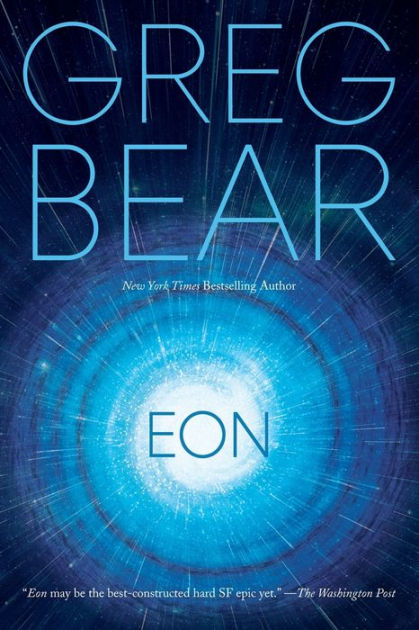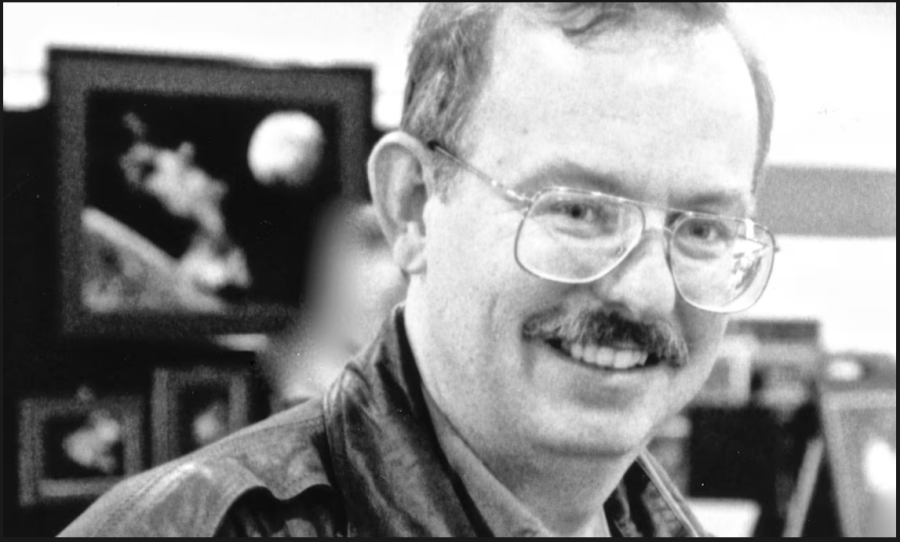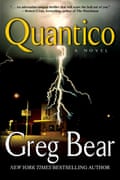I first read the book Eon by Greg Bear several years ago when I was serving 30 days at the Buchanan County Jail for a driving charge. It is an intriguing science fiction novel and I could not put it down once I started it!
That’s the thing about jail… you have all the time in the world, and I typically chose to spend the time curled up in my bunk with a good book. I don’t often take the time to read fiction for pleasure when I am free; I prefer learning as much as I can, absorbing all the non-fiction I can get my hands on. But this book is different; I have thought about it many times over the years since then.
So, I was pleased to see it was sitting on the table waiting for me when I arrived back to BCCC during my most recent jail stay (read An Update for February 2024).

Eon is a poignant and well-written sci-fi novel includes a plethora of psychosocial, philosophical, political, technological, mathematical, astrophysical, and metaphysical themes and implications. It is so advanced and futuristic that it is hard to believe it was published in 1985- the year I was born!

The Plot
The novel follows Patricia Vasquez, a introspective mathematician, as she goes on the adventure of a lifetime! Recruited by NASA and the US Government, Patricia leaves her fiance and parents behind, flying through outer space to board an asteroid that found its way to earth’s orbit.
Inside the hallowed out asteroid referred to as The Stone, teams from the United States, China, the UK, and Russia are already working around the clock to explore the vast chambers found within. In the first of seven chambers, we discover a lush, wild forest ecosystem along with Patricia as she is introduced to the team and given strict instructions to keep quiet about her work. The second chamber houses an immense abandoned cities, complete with an extensive digital library we could only dream of, with many more wonders lying beyond its borders.

Patricia’s job is to solve The Stone’s secrets and the clock is ticking with the threat, reminiscent of the Cold War, hanging over all of their heads. I don’t want to give too much of it away, and honestly I don’t think I could do the book justice anyway!
I didn’t learn until later that Eon is the first of three in a series, but I look forward to reading the others sometime!
Quotes from the Book
“This is a work of fiction. All of the characters, organizations, and events portrayed in this novel are either products of the authors imagination or are used fictitiously.” inside cover
“In the name of Star, Fate, and Pneuma, and the Good Man who sought equality and fair deals for all consumers, and who sought the end of overwhelming and inhuman technology, this meeting of the Infinite Hexamon Nexus convenes.” p 310
“In the name of Star, furnace of our being, forge of our substance, greatest of all fires, Star give us light, give us even in darkness the gift of right creator.
In Fate, we lay our trust, in the Way of Life and Light, in ultimate destiny’s pattern, which we cannot deny, whatever we choose, however freely we choose.
In the name of Pneuma, breath of our minds, wind of our thoughts, born of flesh or carried in machine, guide our hands, enthuse us, that we may create truth ourselves, that we may manifest what is within, without.
And in the name of the Eld, some of whom are with us this occasion, those born of flesh and resurrected by the gifts of our past creativity; in the name of those who burned that we might find a truer path, who suffered the Death that we may live…
I lift this clavicle to worlds without number and bring a new light to the Way, opening this gate that all may prosper, those who guide and are guided, who create and are created, who the light the Way and bask in the Light so given.
Behold I open a- new world.” p 410-411
The definition of information is “the potential that exists between time-like dimensions (time itself, and the fifth dimension separating world lines for example) and space-like dimensions. Wherever space and time interact, there is information, and where information can be ordered into knowledge, and knowledge can be applied, there is intelligence.” p 448
“the true reverse of pain, not pleasure, but a ‘warning’ of healing, growth, and change.” p 448
The Author: Greg Bear
The world lost another brilliant mind and soul on November 19, 2022. Here is his obituary as printed on The Guardian:
The American science fiction writer Greg Bear, who has died aged 71 following heart surgery, was, as he put it “all over the map” as far as interests and subjects were concerned: genetics, starships, politics, artificial constructs and combat in space were among the themes explored in his 35 novels. The work he did to research them with thinkers and institutions made them remarkably prescient, not only scientifically – he is attributed with the first descriptions of nanotechnology – but also politically.

His near-future technothrillers Quantico (2005) and Mariposa (2009), for instance, deal with domestic terrorism, a conflict between federal government and states that threaten to secede, and the rise of a populist president who manipulates the supreme court to his own ends. He developed big ideas, conceptually and physically, into exciting and compelling stories, able to evoke a sense of wonder while possessing a depth of characterisation not often found in novels about cutting-edge science.
A founding member of the Association of Science Fiction and Fantasy Artists (ASFA) in 1976, he served on Jerry Pournelle and Larry Niven’s Citizens Advisory Council on National Space Policy in the 1980s and 90s, and was president of the Science Fiction Writers of America (1988-90).

Born in San Diego, California, Greg was the only son of Wilma (nee Merriman) and Dale Franklin Bear, a meteorologist in the US Navy, stationed in Japan, the Philippines and Alaska. In between, the family were posted to Texas and Rhode Island, Dale serving on aircraft carriers during the Vietnam war before retiring as a lt commander.
From Horace Mann junior high and Pershing middle schools Greg went on to study advanced English at Crawford high school. Already a science fiction fan – a Star Trek enthusiast from the first broadcast – he was soon writing and drawing comics. Through a film club at the school, he met future writers David Clark, John Pound, Scott Shaw and Roger Freedman, and in 1969 the five participated in the early planning for the following year’s Golden State Comic Book Convention. This would evolve into San Diego Comic-Con, now the biggest annual comics and entertainment convention in the US.
Bear continued to draw and paint, providing illustrations to Bjo Trimble and Dorothy Jones Heydt’s self-published Star Trek Concordance (1969) and cover paintings to The Magazine of Fantasy and Science Fiction and Galaxy (the latter illustrating one of his own stories). He has had his paintings exhibited at the Ray Bradbury Museum.
After gaining his BA in English from San Diego State College (now University), Bear worked as a lecturer for tourists at the San Diego Air and Space museum in Balboa Park. He later narrated shows at the Reuben H Fleet Space Theater, which opened in 1973, and worked in secondhand bookshops.
He had sold his first story, Destroyer (1967), to Robert AW Lowndes’ Famous Science Fiction when he was 15. He completed his first novel, a fantasy entitled The Infinity Concerto, at 19, but in the following decade published only a handful of short stories. At the end of the 70s he returned to novels, selling Hegira (1979), Psychlone (1979), Beyond Heaven’s River (1980) and Strength of Stones (1981) in quick succession. The Infinity Concerto was published, much revised, in 1984, followed by a sequel, The Serpent Mage (1986), and the two were later combined as Songs of Earth and Power (1994).
Bear truly found his feet with two stories in 1983: Hardfought, about a far future interstellar war between an ancient race of gas giant-dwelling aliens and humans almost as incomprehensible, and Blood Music, two years later expanded into a novel, in which a scientist creates computerised blood cells, which infect and assimilate humanity into a group mind. Tangents (1986) was an account of a boy who can see the inhabitants of four-dimensional space.
This remarkable run of outstanding work continued with Eon (1985) – to which Bear added a sequel, Eternity (1988), and prequel, Legacy (1995) – concerning the discovery and exploration of a hollowed-out asteroid that contains seven vast chambers; one, The Way, is a corridor that seems to stretch to infinite length, along which exist warring alien races and humanity’s distant descendants.
Bear began constructing a loose future history with Queen of Angels (1990), commencing in 2047 in a socially stratified US and involving psychology, artificial intelligences and a murder plot. Its sequels, Slant (1997) and Heads (1990) explore further the mental and political repercussions of medical and social changes, while in Moving Mars (1993), a scientist from the planet makes a breakthrough that shifts the balance of power with Earth. Darwin’s Radio (1999) and its sequel Darwin’s Children (2003) tell of the spread of a disease that causes miscarriages, soon discovered to be an awakening of non-coding DNA that results in genetically enhanced children – the next step in human evolution.
Bear’s other novels showed his range: The Forge of God (1987) and its sequel, Anvil of Stars (1993), had an alien race plotting the destruction of Earth and the handful of survivors tracking down those responsible; Vitals (2002) and Dead Lines (2004) were techno-thrillers of immortality and phantoms respectively; City at the End of Time (2008) was set in the far distant future; Hull Zero Three (2010) was a mystery set on a rundown generational starship; and War Dogs (2014), Killing Titan (2015) and Take Back the Sky (2016) formed a military SF trilogy.
Bear’s admiration for Star Trek resulted in an original novel Corona (1984). Later franchise novels included Star Wars: Rogue Planet (2000); one volume of a second trilogy continuing Isaac Asimov’s Foundation series, Foundation and Chaos (1998); and the Forerunner Saga trilogy establishing the origins of the Halo computer games universe: Cryptum (2011), Primordium (2012) and Silentium (2013). Bear was also one of a group of writers and others interested in swordplay and western martial arts who created The Mongoliad cycle (2010-12), distributed as apps developed by Neal Stephenson’s Subutai Corporation for smartphones.
His shorter works can be found in the three volumes of The Complete Short Fiction of Greg Bear (2016). His last novel, The Unfinished Land (2021), was a fantasy set in Elizabethan times in which a Spanish galleon drifts into the realm of Tir Na Nog, the otherworld of Irish myth, and shortly before his death he was working on a memoir.
His marriage to Christina Nielson in 1975 ended in divorce six years later. In 1983 he married Astrid Anderson, daughter of the SF writer Paul Anderson. She survives him, along with their daughters Chloe and Alexandra.
Gregory Dale Bear, author, born 20 August 1951; died 19 November 2022
Want new posts in your inbox? Don’t miss out!
Support my work by sharing this blog post! Thank you in advance for your help spreading the word about this important information!


Leave a comment